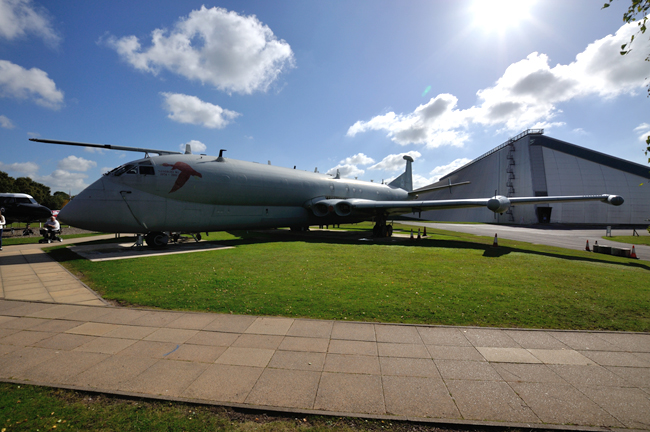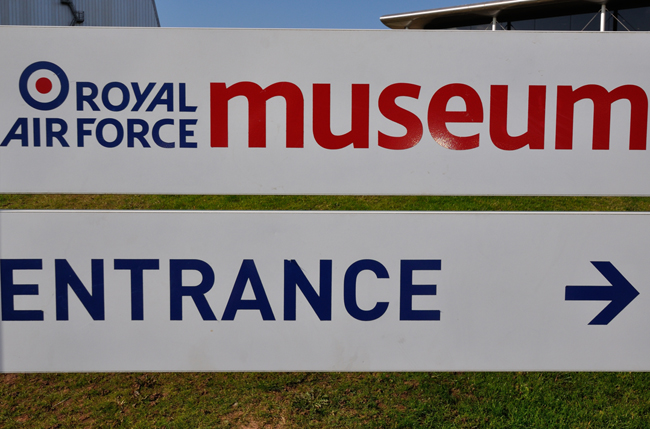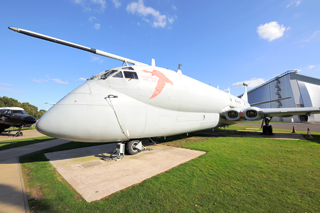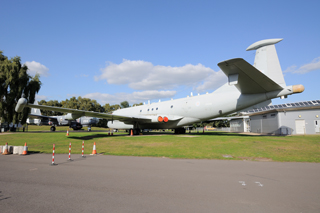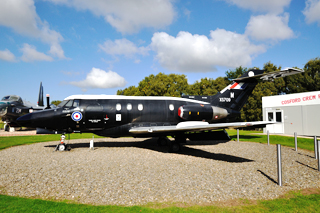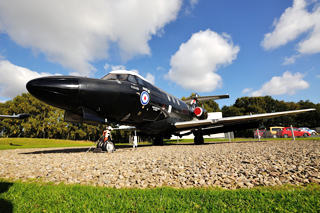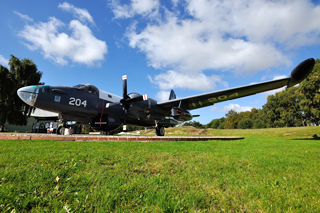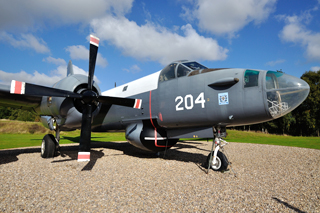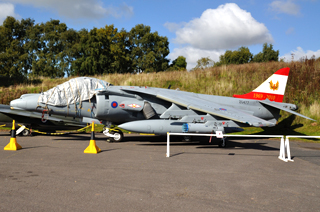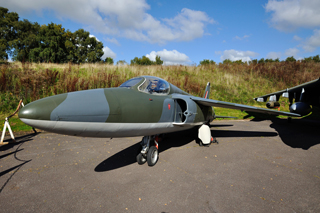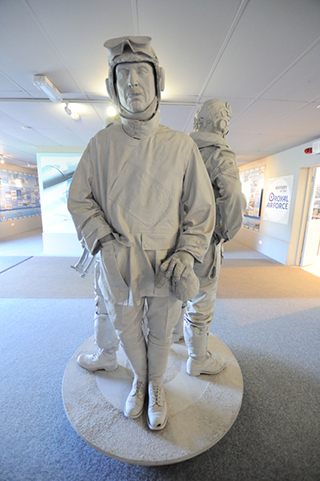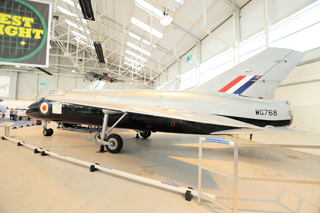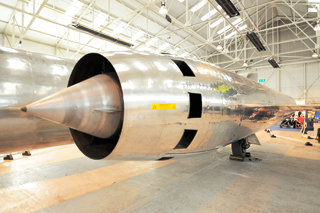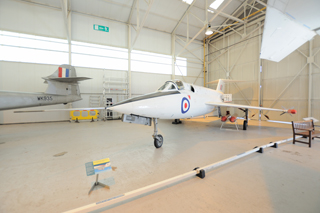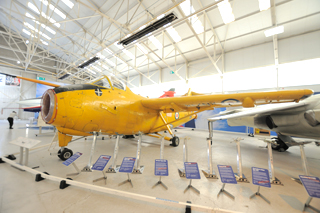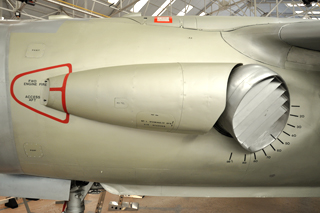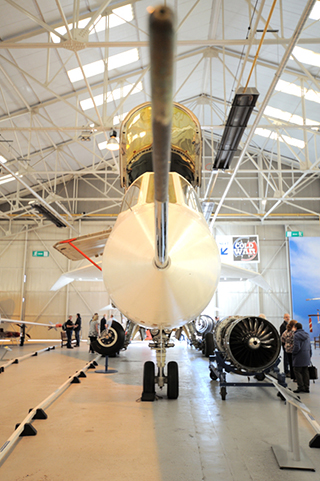This
eFLYER was developed in HTML for viewing with Microsoft Internet Explorer
while connected to the Internet: View
Online.
To ensure delivery to your inbox, please add eFLYER@barnstormers.com to
your address book or list of approved senders.
|
 |
ISSUE 425 - April 2016
Over 9,000 Total Ads Listed
1,000+ NEW Ads Per Week |
| Royal Air Force Museum, Cosford - Part I |
By Kevin Moore, Contributing
Editor & Photographer
Watford, Ontario, Canada |
|
|
| Heading to the Research & Development hangar, one of the first aircraft you see before you get there is the mighty Hawker Siddeley Nimrod. |
| The Royal Air Force has an illustrious history, from it's beginnings as the Royal Flying Corps to the modern day RAF flying high performance and supersonic aircraft. Much of the history of the RAF can be found inside the 2 RAF museums, Hendon and here at Cosford. |
|
You can't miss the sign that points you in the right direction to see
lots of historic and rare aircraft at RAF Museum, Cosford. |
| Only a short drive from the historic city of Birmingham, and just minutes from the M54 motorway, RAF Cosford is certainly worth the drive from where-ever you are in England. Free entry gives you access to over 70 aircraft, their National Cold War display, the Research & Development hangar, the Transport & Training hangar, the War in the Air hangar and the National Cold War Exhibit as well as interactive displays and assorted events throughout the year, including an airshow. |
|
|
Marine Patrol Aircraft Hawker Siddeley Nimrod,
an airframe based on the beautiful de Havilland Comet airliner. |
| After you walk through the main entrance building and step outside to get to the first main hangar, you are greeted by 3 aircraft, the first on the left being the big Hawker Siddeley Nimrod, used by the RAF as a Marine Patrol Aircraft and was based on the de Havilland Comet airliner. The Nimrod was first flown in 1967 and served with the RAF from 1970 to 2010. It had a service ceiling of 44,000 feet, a cruise speed of 490mph (NES of 575mph) and a range of almost 6000 miles. |
|
|
| The Dominie was used to train navigators for the Avro Vulcan and Victor. |
| Across from the Nimrod is the Hawker Siddeley Dominie T.1. Originally designed as a business jet, with a passenger capacity of 8 and 2 pilots. The RAF utilised the aircraft to train navigators for the Avro Vulcan and Victor, replacing the Vickers Varsity. The Dominie served with the RAF for over 46 years, had a cruise speed of 432mph and a service ceiling of 41,000 feet. |
|
|
Marine Patrol Aircraft Lockheed Neptune was used by
several air forces including the RAF and the Dutch Air Force. |
| Just beyond the Dominie is the Lockheed SP-2H Neptune which was used as a land based Maritime patrol and anti-submarine aircraft. The Neptune was designed during World War II and first flew in May of 1945. The aircraft is powered by two piston engines and, for use with assisted power take-offs and extra power when needed to reach submarine contacts, it was also fitted with 2 jet pods. The Neptune served with the RAF, as well as several other Air Forces around the world. |
|
|
| Sitting outside with a tarp protecting the cockpit was the Harrier GR9 along with the tiny Folland Gnat, left. Side view of the Harrier GR9, unfortunately,
sporting a tarp for protection from the elements, right. |
| Temporarily stored outside due to an event being held in the museum were several aircraft including an RAF GR9 Harrier and RAF Folland Gnat. The Harrier first flew in 1960 as the Hawker P.1127, referred to as the Kestrel. It was originally designed to operate from non-airport locations such as car parks, forests, etc due to it's VTOL (Vertical Take Off and Landing) capabilites. There were several different generations of Harrier aircraft built from the GR.1 to GR.9, the FRS.1, FA2 and FRS Mk.51. Different generations were built by assorted manufacturers and consortiums including Hawker Siddeley, BAE, Boeing and McDonnell Douglas. Currently, Harriers are still flown in the USA, Spain, Italy and India. |
|
|
| The Folland Gnat is a small, agile jet fighter developed as a more affordable aircraft but was adopted by the RAF for use with the RAF Yellow Jackets & RAF Red Arrows. |
| The Folland Gnat was a single seat, low-cost fighter that came about due to the ever increasing cost of fighter aircraft. It was considered to be a highly manoeuvrable aircraft and had a very good turn of speed. However, due to defence spending cuts, the aircraft was not ordered by the RAF. It was, however, ordered by Finland and India and was built under license by Hindustan Aircraft Limited for the Indian Air Force. Eventually, the RAF ordered the Gnat for use by the RAF Yellow Jackets who became the RAF Red Arrows. |
|
The Handley Page Jetstream which was used to train multi-engine pilots
and navigators, replacing the Vickers Varsity. |
| The last of the aircraft displayed outdoors is the Handley Page Jetstream. The Jetstream was originally designed as an executive light transport and first flew in 1967. Sadly, Handley Page was forced into liquidation 2 years later due to developmental costs of the Jetstream, as well as poor sales, and production of the aircraft was transferred to Scottish Aviation Ltd in Prestwick. The British Ministry of Defence ordered 26 aircraft for Training Command to be used in training multi-engine pilots and navigators, replacing the Vickers Varsity. The Jetstream was removed from service with the RAF in 2004 and replaced by the Beech King Air. |
|
|
From the early days of the RFC to the more modern times of the RAF,
there were three life size statues of pilots on display and here are 2 of the 3. |
| As you enter the first, large museum building known as the Research & Development hangar, you enter a room filled with a number of displays including a life size set of 3 generations of RAF pilots. Other displays included historical information on the walls offering insight into the history of manned flight, powered flight, aviators and the RAF. When visiting the museum, give yourself time to browse and read through the displays in this first museum room. |
|
A very sleek looking supersonic aircraft designed and built by
Fairey Aviation Company, the Fairey FD2. |
| You then enter the main hangar area of the museum housing an assortment of aircraft, the first of which you may notice will be the delta winged Fairey Delta 2 or FD2. An interesting design that included a nose section that was capable of being lowered downward by 10 degrees for better visibility during ground handling/taxiing/take off. The aircraft first flew in October of 1954 and broke the world speed record in 1956 by more than 300mph, beating the record set the previous year by the US built F100 Super Sabre. Sadly, only two Fairey Deltas were ever built. |
|
|
The Short SB5 may have a bit of a familiar look to it for many
and that's because it was a sort of test bed for the EEC Lightning. |
| Another rare aircraft in the hangar is the Short SB5, an aircraft that was built to test the design of the wing and tail areas for a new fighter design known as the Lightning. Controversy between the English Electric Company and the Royal Aircraft Establishment arose regarding the best configuration required for a new supersonic fighter aircraft. A test machine was required and the contract for that aircraft was awarded to the Short Brothers and Harland Ltd. The design included three different wing sweep angles of 50, 60 and 69 degrees as well as two different tail plane positions including a lower and upper horizontal stab position. The result was that the English Electric Company low tail configuration was the correct version and a wing sweep of 69 degrees was ideal. From that, the English Electric Lightning was developed. |
|
|
| The Stainless Steel Bristol Type 188, left, and one of two of the massive de Havilland Gyron Junior engine, right, that powered the 188. |
| One of the more interesting and unique looking aircraft in the collection is the Bristol Type 188 which was built, mainly, of stainless steel and was designed to test the effects of heat at very high speeds on aircraft structures. It included a protective cockpit for the pilot who was surrounded by a refrigeration system and first flew in 1962. Only two 188s were built, both powered by the de Havilland Gyron Junior engines, and the aircraft reached Mach 1.88, though fell short of the goal of reaching Mach 2. Lack of required speed, an endurance of only 25 minutes and fuel leaks saw the cancellation of the aircraft in 1964. |
|
|
| The unusual & odd looking Gloster Meteor F8 Prone Position test aircraft. |
| Arguably the oddest looking aircraft in the collection is the Gloster Meteor F8 Prone Position, a highly modified version of the Gloster Meteor F8. The aircraft was designed to evaluate any possible advantages of having the pilot lying down, or in the prone position, with the effects of gravity. The reasons for testing such a design was to allow the pilot the ability to withstand greater "g" forces verses sitting in an upright position and, in a prone position cockpit, the front section of the fuselage could be reduced allowing for less drag. Some 50 plus hours were flown on the aircraft, though it was never flown solo, and assessments determined that, while a pilot could fly in a prone position aircraft, the introduction of the 'g-suit' meant that the advantages of a prone position cockpit were outweighed. It was also said that it was difficult for the pilot to operate the controls of the aircraft whilst in the prone position. |
|
|
Probably the most controversial aircraft ever designed & built in Britain,
the British Aircraft Corporation TSR 2 prototype. |
| One of the favourite aircraft in the collection, and one of the most controversial, is the British Aircraft Corporation TSR 2 prototype. The RAFs need for a high speed, low level strike aircraft to replace the EEC Canberra lead to the design and building of the TSR 2 (Tactical Strike & Reconnaissance Mach 2) aircraft which first flew from Boscombe Down in September of 1964. Though early reports had indicated that the TSR 2 was a great success, political opposition to the costly project lead to its cancellation in 1965, a similar fate which lead to the demise of the Canadian designed & built Avro Arrow. The TSR 2 XR219, the first prototype, flew 24 flights, with the museums aircraft next to join the testing phase. However, the programme was cancelled before this aircraft could participate in further flight testing. |
|
|
| The Saunders-Roe SR53 interceptor that could reach speeds of Mach 2. |
| The Saunders-Roe SR.53 was both a rocket and jet engine powered aircraft. Designed to rapidly climb to high altitudes using the rocket power and then fly at altitude using the jet engine for better fuel consumption, the SR.53 was designed to meet an Operational Requirement for a rocket interceptor and, though work on the aircraft began in 1952, there were several developmental delays and the first prototype did not fly until spring of 1957. The aircraft reached speeds of Mach 2 at altitude. Sadly, the second prototype crashed, killing test pilot Squadron Leader John Booth, when it exploded at the end of the runway at Boscombe Down. Despite changes in design, including the newer version SR177, further development was discontinued due to government cutbacks of the time, known as the Defence White Paper. |
|
| The predecessor of the Eurofighter Typhoon, the BAe EAP. |
| One of the more modern of aircraft in the museum is the BAe EAP which, through development, became the Eurofighter Typhoon. The EAP was initially designed as a cooperation between Britain, Italy and Germany however, the Italians and Germans both left the program. Development continued with British Aerospace along with assistance from both the German and Italian suppliers and the aircraft was first rolled out and flew in 1986. This was the only EAP aircraft ever built and, after making hundreds of flights, the last one in 1991, it was used as a training aircraft at Loughborough University before being donated to the RAF Museum. If you visit the museum website, you can see a 360 degree view of the aircraft. |
|
| The SEPCAT Jaguar ACT, developed as a fly-by-wire test aircraft for the Eurofighter. |
| Next is the SEPECAT Jaguar ACT, which was used to help develop the fly-by-wire system utilised in the Eurofighter Typhoon. Though the aircraft was initially built as a Jaguar GR.1, ground attack version, it was returned to the factory where it was modified by removing its flying control system and replaced with an electronic fly-by-wire system as well as the addition of leading edge strakes. Though the aircraft saw significant performance improvement, these changes also made for an unstable aircraft in certain speed ranges and computer controls were required to keep the aircraft stable. It had a top speed of 990mph at 36,000 feet using two Rolls-Royce Adour Mk 102 turbofan engines. |
|
|
| The Hunting 126 had an extremely slow stall speed of 32mph, surprising for a jet.. but there's a reason why it could fly so slow... read on. |
| Another rather odd looking aircraft in this section of the museum is the Hunting 126 Research Prototype, a jet aircraft that was capable of very slow speeds as low as 32mph using something called "jet flaps." These flaps ducted thrust downward from the main engine which increased lift and was used to improve both landing and take-off performance thereby being able to utilise the use of shorter runways. The aircraft used 16 engine exhaust nozzles which were positioned along the trailing edges of the wings. These nozzles directed more than half of the engines exhaust gases over the flaps upper surfaces. In addition to this, 10% of the engine exhaust was also directed through more nozzles that were placed in the wingtips and tail to assist with control at lower airspeeds. The aircraft first flew in 1963 however, despite flight testing with the RAE and wind tunnel testing in the USA with NASA, the aircraft was placed in storage upon returning to England until eventually finding a home at RAF Cosford. |
|
|
| The aircraft that the Hawker Harrier was developed from, the Hawker P1127 Kestrel, left, and one of the jet engine nozzles, right, that allowed the Kestrel, and eventually the Harrier, to perform vertical take off and landing, among other manoeuvres. |
| An aircraft which may look familiar to many is the Hawker Harrier however, its beginnings are thanks to the development of the Hawker-Siddeley Kestrel FGA.1 which later became the Harrier. The Kestrel was developed from the P.1127 and tested with the "Tripartite Evaluation Squadron," TES, and nine of the type were built and tested by pilots from the UK, West Germany and USA evaluating vertical take off in 'near service conditions.' The eventual proven Harrier flew nearly a year after testing was completed on the Kestrel. |
|
| The prototype EEC P1A, forerunner of the English Electric Lightning. |
| The English Electric P1A was an experimental aircraft that first flew in 1954 and was the forerunner of the English Electric Lightning. As earlier mentioned, testing on the unique wing and tail design of the eventual Lightning was performed by the Short Brothers aircraft, the SB5, and the P1A was further confirmation of the design. The P1A was the first of two prototype aircraft that exceeded the speed of sound in level flight reaching Mach 1.22. The ultimate design became the EEC/BAE Lightning which served the RAF for 3 decades. |
|
|
| A look at the TSR 2 head on, left, and from the rear, right. |
| This week we had a look at some of the aircraft inside and out at RAF Cosford. Next week, we'll return to RAF Cosford to have a look at more of the many aircraft and exhibits available when you visit the museum. |
|
| Developed during the latter part of World War II, the Avro Lincoln saw no action during the war but was Bomber Commands post-war mainstay bomber of the RAF. |
|
|
| This week we looked at the Bristol Type 188, left, a supersonic aircraft that never went into production. Next week, we'll look at one that did, the English Electric Lightning, right. |
|
| |
|




